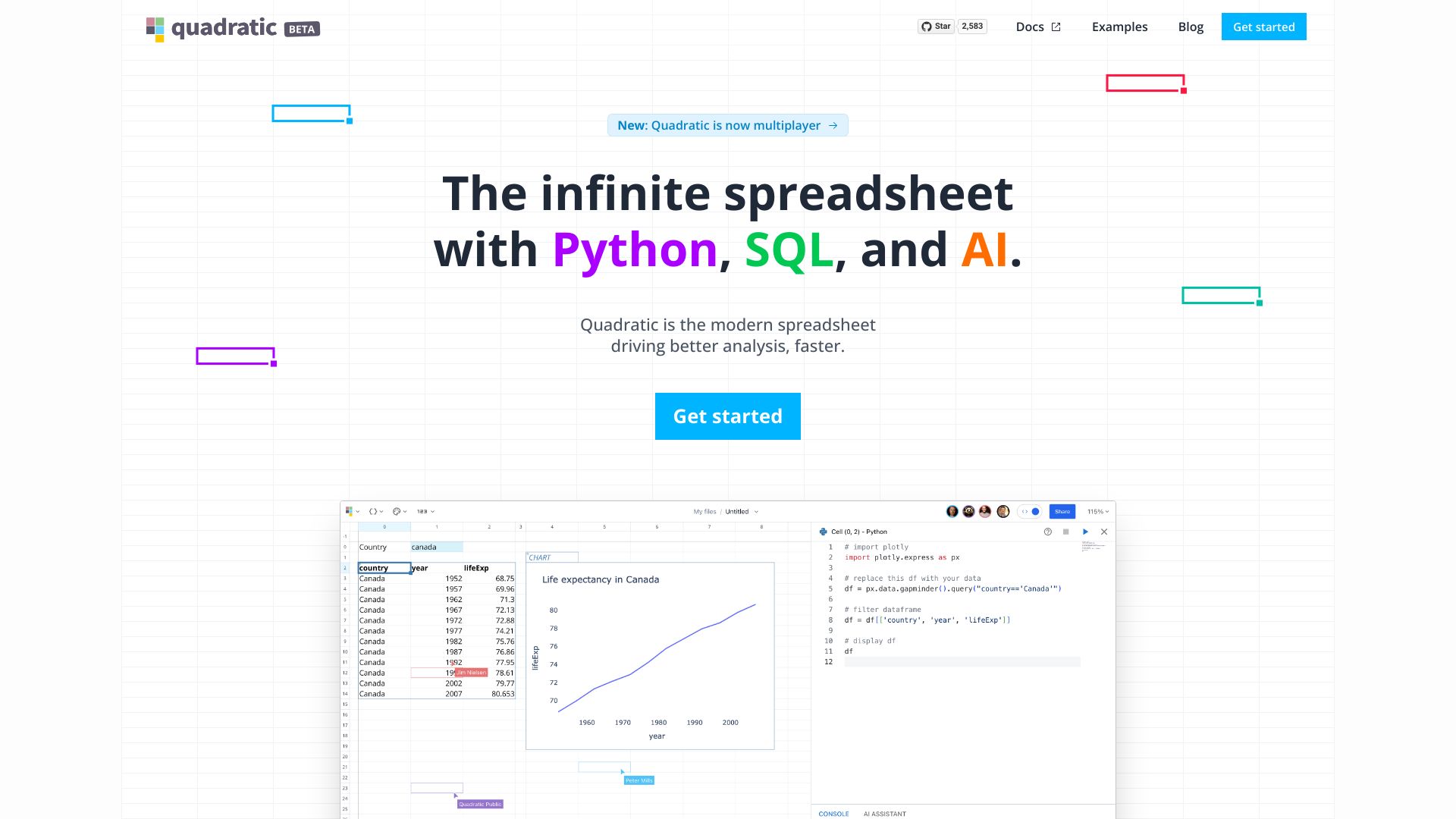- Home
- SQL Query Builder
- Quadratic

Quadratic
Open Website-
Tool Introduction:Browser spreadsheet with Python, AI, and live collaboration for data teams.
-
Inclusion Date:Oct 28, 2025
-
Social Media & Email:
Tool Information
What is Quadratic AI
Quadratic AI is a modern, browser-based spreadsheet that combines traditional formulas, native Python, and an integrated AI assistant in a single high-performance workspace. Built for analysts, data scientists, and developers, it enables rapid data exploration, database connections, and clear visualizations without switching tools. Real-time collaboration and cell-level computation support reproducible workflows, while AI helps generate code, explain results, and automate data cleaning. Quadratic streamlines analysis by unifying spreadsheets, code, and AI in a familiar grid interface.
Quadratic AI Main Features
- Native Python in cells: Run Python directly in the grid to analyze data, prototype models, and reuse existing code without leaving the spreadsheet.
- Spreadsheet formulas: Use familiar functions for quick calculations, lookups, and transformations alongside code-driven logic.
- Built-in AI assistant: Generate formulas, write Python snippets, explain outputs, and suggest cleaning or transformation steps.
- Real-time collaboration: Edit simultaneously, see live changes, and keep teams aligned in the browser.
- Database connections: Connect to data sources to query, join, and refresh datasets directly in the sheet.
- High-performance engine: Handle sizable data and computations efficiently with responsive cell execution.
- Visualization tools: Create charts and basic dashboards to communicate insights quickly.
- Reproducible workflows: Keep logic, code, and outputs together for transparent analysis and easy handoffs.
Who Should Use Quadratic AI
Quadratic AI suits analysts who need a faster, more flexible spreadsheet, data scientists who want lightweight Python-powered exploration, and developers who prefer coding in a grid with team-friendly collaboration. It also fits cross-functional teams building data prototypes, product analytics, finance and operations reporting, and lightweight dashboards without maintaining separate notebooks, BI tools, and spreadsheets.
How to Use Quadratic AI
- Open Quadratic in your browser and create a new spreadsheet.
- Import data from files or connect a database to pull live tables or queries.
- Choose the cell mode: write formulas for quick math, or use Python for richer analysis and models.
- Use the AI assistant to generate formulas or Python code, explain results, or propose cleaning steps.
- Transform and join data, then create charts to visualize trends and outliers.
- Collaborate in real time: invite teammates, co-edit, and review changes.
- Share or export results, and refresh connected data as sources update.
Quadratic AI Industry Use Cases
Finance teams can build driver-based models and scenario analyses with live database inputs. E-commerce analysts can join order, product, and campaign data, then visualize funnel metrics in one sheet. Data science teams can prototype Python-based features or data prep steps before productionizing. Operations teams can track KPIs from multiple sources, apply AI-assisted data cleaning, and share lightweight dashboards with stakeholders.
Quadratic AI Pros and Cons
Pros:
- Combines formulas, Python, and AI in one familiar spreadsheet interface.
- Real-time collaboration in the browser, reducing tool switching.
- Direct database connectivity for live, refreshable analysis.
- Good for rapid prototyping, exploration, and sharing results.
- Reproducible workflows with logic and outputs in the same grid.
Cons:
- Browser-based environment may struggle with extremely large datasets.
- Learning curve for users new to Python or AI-assisted workflows.
- AI-generated code or formulas may need review for accuracy.
- May not replace specialized BI tools for advanced visualization at scale.
- Package or environment limitations compared to full local Python setups.
Quadratic AI FAQs
-
How is Quadratic AI different from Excel or Google Sheets?
It natively supports Python and integrates an AI assistant, enabling code-driven analysis alongside formulas, all within a collaborative browser spreadsheet.
-
Can I use popular Python libraries?
Quadratic supports Python in cells for data manipulation and analysis; library availability depends on the environment configuration for the workspace.
-
What can the AI assistant do?
It can propose formulas, write Python snippets, explain outputs, suggest cleaning steps, and help translate analysis goals into executable steps.
-
Does it support real-time collaboration?
Yes. Multiple users can edit the same spreadsheet concurrently and see live updates in the browser.
-
Can I connect to databases?
Yes. You can connect to data sources, run queries, and refresh data to keep analyses up to date.

